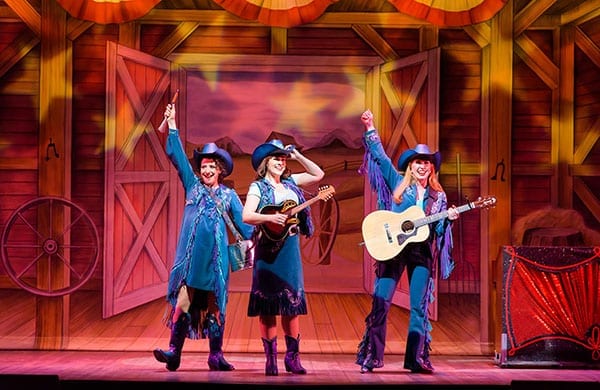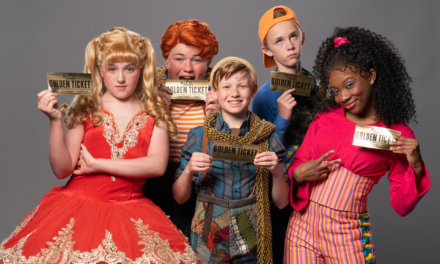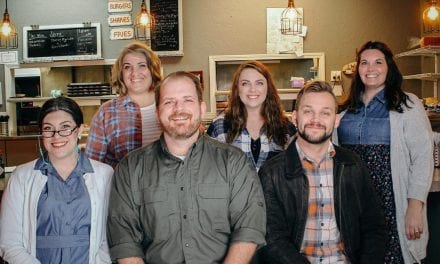SALT LAKE CITY — Musical theatre is just that: musical. But in most shows the music is either canned or comes from a live orchestra. Few plays have the actors themselves providing all the music. Enter Pioneer Theatre Company’s production of Cowgirls.

Show closes April 9, 2016.
The unique country/classical musical is set in a small town in Kansas. Hiram Hall, an old country music hall, is on the brink of foreclosure. In a final attempt at revival, the owner, Jo, hires a cowgirl trio to perform at the grand re-opening. Problem is, the trio is actually a set of classical artists. Rather than waste a perfectly good booking, the three decide to go country in order to help save the old theatre. From Chopin to country in a single day, the show covers the awkward, rocky journey along the way. Country music and classical music might not seem like they have anything in common, but Betsy Howie’s script made the juxtaposition of the two seem almost natural, tying together a love of music of all kinds.
 The plot was slow to develop, but the characters were endearing and the songs were heartfelt. The show’s tunes (with music and lyrics by Mary Murfitt) ranged from catchy (“Honky Tonk Girl”) to heart breaking (“Don’t Look Down”), taking the audience on an emotion roller coaster and showing off a depth that continues to develop throughout the show. They also revealed much of the plot and background information, so it’s important to pay close attention.
The plot was slow to develop, but the characters were endearing and the songs were heartfelt. The show’s tunes (with music and lyrics by Mary Murfitt) ranged from catchy (“Honky Tonk Girl”) to heart breaking (“Don’t Look Down”), taking the audience on an emotion roller coaster and showing off a depth that continues to develop throughout the show. They also revealed much of the plot and background information, so it’s important to pay close attention.
The all-female, six-member cast was impressive. In fact, these ladies are the whole package—they can sing, dance, act, and play almost every instrument imaginable, including piano, guitar, violin, mandolin, banjo, cello, harmonica, and accordion. Leenya Rideout played Jo, the down-on-her-luck hall owner. Although her character was not a musical force at the beginning of the show, she went on to steal the spotlight and proved Rideout was a country natural. She not only showed off her wide range of vocal skills in her solos, but she also gave some impressive performances on the guitar. When Rideout started to sing, it quickly became apparent that she was the real star of Cowgirls. Her solo “It’s Time to Come Home,” started as a bluesy ballad and ended with a long, powerful high note. And during all of it she accompanied herself on the guitar.
 Angela Chatelain Avila, Jessica Bradish, and Lindsay Zaroodian portrayed Mary Lou, Lee, and Rita, the classical-gone-country trio. All three actresses were equally talented in their vocal and musical instrument skills. Avila’s character took most of the play to open up, but once the shell was cracked, she proved that she can fiddle with the best of them. Her transformation from prim and proper to downright country was apparent during her fiddle solo at the end of “House Rules.” Bradish’s enthusiasm led the group valiantly as they slowly turned cowgirl, and made a seamless transition from the cello to the guitar. Although Zaroodian was a bit light on her feet for an incredibly pregnant character, she showed off some intricate and varied skills as she tickled the ivories. I spent the better half of the play trying to tell if she was actually playing the piano or not. To her great credit, it was not only live, but she didn’t miss a single note.
Angela Chatelain Avila, Jessica Bradish, and Lindsay Zaroodian portrayed Mary Lou, Lee, and Rita, the classical-gone-country trio. All three actresses were equally talented in their vocal and musical instrument skills. Avila’s character took most of the play to open up, but once the shell was cracked, she proved that she can fiddle with the best of them. Her transformation from prim and proper to downright country was apparent during her fiddle solo at the end of “House Rules.” Bradish’s enthusiasm led the group valiantly as they slowly turned cowgirl, and made a seamless transition from the cello to the guitar. Although Zaroodian was a bit light on her feet for an incredibly pregnant character, she showed off some intricate and varied skills as she tickled the ivories. I spent the better half of the play trying to tell if she was actually playing the piano or not. To her great credit, it was not only live, but she didn’t miss a single note.
 Karis Danish and Ashlie Roberson played Jo’s sidekicks, Mickey and Mo. Although they are more side characters, they captured my attention in every one of their scenes. Roberson’s banjo skills were remarkable. But what made the duo memorable were Mickey and Mo’s fun personalities, witty remarks, and body language (such as eye rolls, huffing, etc.). I especially loved when they came out and chatted with the audience, making jokes and small talk, and even taking a few audience members up on stage. Danish’s characterization of Mickey was superb, especially during the song “Don’t Call Me Trailer Trash,” which described her mobile home upbringing and cowgirl-all-the-way mantra. This song, which also explained why Micky is the way she is, was well executed by Danish, as she beautifully personified Mickey’s complexities.
Karis Danish and Ashlie Roberson played Jo’s sidekicks, Mickey and Mo. Although they are more side characters, they captured my attention in every one of their scenes. Roberson’s banjo skills were remarkable. But what made the duo memorable were Mickey and Mo’s fun personalities, witty remarks, and body language (such as eye rolls, huffing, etc.). I especially loved when they came out and chatted with the audience, making jokes and small talk, and even taking a few audience members up on stage. Danish’s characterization of Mickey was superb, especially during the song “Don’t Call Me Trailer Trash,” which described her mobile home upbringing and cowgirl-all-the-way mantra. This song, which also explained why Micky is the way she is, was well executed by Danish, as she beautifully personified Mickey’s complexities.
The costumes were all ideal for the production, and they kept with the flow of the show. Costume designer Gregory Gale incorporated subtle consistencies within each trio (i.e., the Hiram Hall denizens and the classical trio), even as the musicians transitioned into their country attire. Jo, Mo, and Mickey started out in everyday cowgirl garb (cowboy boots, plaid, short shorts, mini skirts), whereas the classical trio was dressed much more stiffly in business skirts, dresses, and dress pants. But even after they had “gone country” the musicians still retained their individual personalities. Lee wore 1970’s dress pants, Mary Lou wore a business skirt and boots, and Rita wore a maternity-style dress—each had a little bit of cowgirl flair. The entire play took place in Hiram Hall, and the set had the authentic feel of a country music dance hall. Scenic designer James Noone ensured that no detail was left out—the old music hall was complete with a jukebox, florescent beer signs, saloon-style doors, old whiskey bottles, and more.
 Director Karen Azenberg kept a nice balance in the show as the songs ranged from fun and lighthearted to bleak and depressing. “The Saddle Tramp Blues” was a fun number—featuring Avila twirling about the stage, throwing off her barriers and dancing on the bar. But “Looking for a Miracle” was a more somber song, so the lighting dimmed and focused on each singer in turn as they sat around the hall, describing their inward struggles. The lighting (designed by Kirk Bookman) that accompanied each song seemed to match the mood and focus the audience from the large stage to the actress’ moment in the spotlight. I especially like how she incorporated the audience into the play, making it the Hiram Hall audience for the show within the show.
Director Karen Azenberg kept a nice balance in the show as the songs ranged from fun and lighthearted to bleak and depressing. “The Saddle Tramp Blues” was a fun number—featuring Avila twirling about the stage, throwing off her barriers and dancing on the bar. But “Looking for a Miracle” was a more somber song, so the lighting dimmed and focused on each singer in turn as they sat around the hall, describing their inward struggles. The lighting (designed by Kirk Bookman) that accompanied each song seemed to match the mood and focus the audience from the large stage to the actress’ moment in the spotlight. I especially like how she incorporated the audience into the play, making it the Hiram Hall audience for the show within the show.
Cowgirls not only addressed each of the characters’ personal problems and concerns, but also contained an underlying message about the struggle of women’s equality and rights. Patrons should be aware that the show does contain some language and suggestive references that may not be suitable for children. Nevertheless, it is rare to find a cast whose talent surprises me throughout the evening, but this one did, as they took their performances up a notch with each scene. Although the show didn’t begin as one of my favorites, the talented cast ended up winning me over in the end. If you’re looking for a fun night out, slip on your cowboy boots and check out Pioneer’s Cowgirls.




